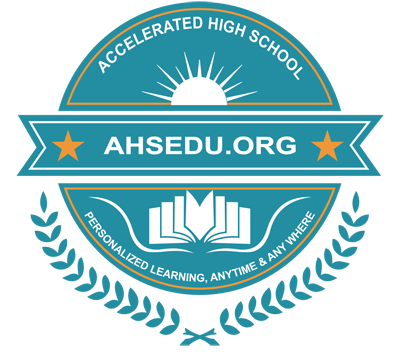Accelerated High School
Standardized Curriculum of General Mathematics-IV
Mathematical knowledge and skills are essential for navigating the complexities of the 21st century. Understanding and applying mathematical concepts is crucial for personal decision-making, civic participation, and career readiness. Accelerated High School (AHS) aligns its curriculum with various educational standards to ensure comprehensive coverage of mathematical principles and their practical applications.
Mission:
All students will understand the mathematical concepts and processes required for personal decision-making, participation in civic life, and preparation for future academic and career pursuits.
Vision:
Prepare students to become mathematically literate individuals who can effectively:
- Apply mathematical thinking and skills to solve real-world problems.
- Engage in logical reasoning and develop problem-solving strategies.
- Conduct investigations, analyze data, and interpret results.
- Discuss mathematical concepts and their applications.
- Read and evaluate multiple sources of mathematical information.
- Communicate mathematical ideas through various forms, including reports, presentations, and visual displays.
Spirit and Intent:
The AHS mathematics curriculum has been prepared and standardized following The New Jersey Student Learning Standards (NJSLS), including the Student Learning Standards for Career Readiness, Life Literacies, and Key Skills, as well as the Student Learning Standards for Personal Financial Literacy. These standards outline the expectations for what students should know and be able to do, promoting a comprehensive approach to mathematical instruction. From the earliest grades, students are expected to engage in learning experiences that develop their understanding of mathematical concepts, improve their problem-solving skills, and enhance their ability to apply mathematics in various contexts.
Three Dimensions of AHS Mathematics Curriculum:
In Grade 4, instructional time should focus on three critical areas:
(1) developing understanding and fluency with multi-digit multiplication, and developing an understanding of dividing to find quotients involving multi-digit dividends;
(2) developing an understanding of fraction equivalence, addition, and subtraction of fractions with like denominators, and multiplication of fractions by whole numbers;
(3) understanding that geometric figures can be analyzed and classified based on their properties, such as having parallel sides, perpendicular sides, particular angle measures, and symmetry.
(1) Students generalize their understanding of place value to 1,000,000, understanding the relative sizes of numbers in each place. They apply their understanding of models for multiplication (equal-sized groups, arrays, area models), place value, and properties of operations, in particular the distributive property, as they develop, discuss, and use efficient, accurate, and generalizable methods to compute products of multi-digit whole numbers. Depending on the numbers and the context, they select and accurately apply appropriate methods to estimate or mentally calculate products. They develop fluency with efficient procedures for multiplying whole numbers; understand and explain why the procedures work based on place value and properties of operations; and use them to solve problems. Students apply their understanding of models for division, place value, properties of operations, and the relationship of division to multiplication as they develop, discuss, and use efficient, accurate, and generalizable procedures to find quotients involving multi-digit dividends. They select and accurately apply appropriate methods to estimate and mentally calculate quotients, and interpret remainders based upon the context.
(2) Students develop an understanding of fraction equivalence and operations with fractions. They recognize that two different fractions can be equal (e.g., 15/9 = 5/3), and they develop methods for generating and recognizing equivalent fractions. Students extend previous understandings about how fractions are built from unit fractions, composing fractions from unit fractions, decomposing fractions into unit fractions, and using the meaning of fractions and the meaning of multiplication to multiply a fraction by a whole number.
(3) Students describe, analyze, compare, and classify two-dimensional shapes. Through building, drawing, and analyzing two-dimensional shapes, students deepen their understanding of the properties of two-dimensional objects and their use of them to solve problems involving symmetry.
Curriculum for Grade-IV Mathematics
Standard 1: Number and Operations in Base Ten
Learning Objectives:
- Use place value understanding and properties of operations to perform multi-digit arithmetic.
- Use place value understanding to round whole numbers to the nearest 10 or 100.
- Fluently add and subtract within 1000 using strategies and algorithms based on place value, properties of operations, and/or the relationship between addition and subtraction.
- Multiply a whole number of up to four digits by a one-digit whole number, and multiply two two-digit numbers, using strategies based on place value and the properties of operations. Illustrate and explain the calculation by using equations, rectangular arrays, and/or area models.
- Find whole-number quotients and remainders with up to four-digit dividends and one-digit divisors, using strategies based on place value, the properties of operations, and/or the relationship between multiplication and division. Illustrate and explain the calculation by using equations, rectangular arrays, and/or area models.
Topics of AHS-GM:
Place Value:
- Place value names
- Value of a digit
- Writing numbers up to one million: convert between words and digits
Ordering and comparing:
- Compare numbers up to one million
- Order numbers up to one million
Rounding:
- Rounding: up to hundred thousand place
- Rounding input/output tables
Addition:
- Estimate sums
- Add 3 or more numbers up to millions
Subtraction:
- Estimate differences
- Add 3 or more numbers up to millions
Multiplication:
- Multiply by multiples of 10, 100, and 1,000
Division:
- Division facts to 10
- Division facts to 12
- Divide 2-digit numbers by 1-digit numbers: quotients up to 10
Standard 2: Operations and Algebraic Thinking
Learning Objectives:
- Gain familiarity with factors and multiples.
- Find all factor pairs for a whole number in the range 1–100. Recognize that a whole number is a multiple of each of its factors. Determine whether a given whole number in the range 1–100 is a multiple of a given one-digit number. Determine whether a given whole number in the range 1–100 is prime or composite.
- Use place value understanding and properties of operations to perform multi-digit arithmetic.
Topics of AHS-GM:
Prime and composite numbers:
- Prime and composite: up to 20
- Prime and composite: up to 100
Mixed operation:
- Add and subtract numbers ending in zeros
- Add, subtract, multiply, and divide
- Choose numbers with a particular sum, difference, product, or quotient
- Solve equations
Standard 3: Number and Operations – Fractions
Learning Objectives:
- Extend understanding of fraction equivalence and ordering.
- Explain why a fraction a/b is equivalent to a fraction (n × a)/(n × b) by using visual fraction models, with attention to how the number and size of the parts differ even though the two fractions themselves are the same size. Use this principle to recognize and generate equivalent fractions.
Topics of AHS-GM:
Mixed numbers:
- Fractions and mixed numbers with denominators of 10 and 100
- Convert mixed numbers to improper fractions
Standard 4: Measurement
Learning Objectives:
- Solve problems involving measurement and conversion of measurements from a larger unit to a smaller unit.
- Know relative sizes of measurement units within one system of units including km, m, cm, mm; kg, g; lb, oz.; l, ml; hr, min, sec. Within a single system of measurement, express measurements in a larger unit in terms of a smaller unit. Record measurement equivalents in a two column table.
Topics of AHS-GM:
Metric units of measurement:
- Compare and convert metric units of length
- Compare and convert metric units of weight
Standard 5: Geometry
Learning Objectives:
- Draw and identify lines and angles, and classify shapes by properties of their lines and angles.
- Draw points, lines, line segments, rays, angles (right, acute, obtuse), and perpendicular and parallel lines. Identify these in two-dimensional figures.
- Classify two-dimensional figures based on the presence or absence of parallel or perpendicular lines, or the presence or absence of angles of a specified size. Recognize right triangles as a category, and identify right triangles.
- Recognize a line of symmetry for a two-dimensional figure as a line across the figure such that the figure can be folded along the line into matching parts. Identify line-symmetric figures and draw lines of symmetry.
Topics of AHS-GM:
Angle measurement:
- Acute, right, obtuse, and straight angles
- Angles of 90, 180, 270, and 360 degrees
- Measure angles on a circle
Quadrilaterals:
- Identify parallelograms
- Identify trapezoids
- Identify rectangles
- Identify rhombuses
- Classify quadrilaterals
Symmetry:
- Identify lines of symmetry
- Draw lines of symmetry







